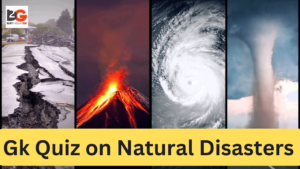Explore your knowledge about natural disasters with our engaging Gk Quiz on Natural Disasters! Test your awareness of earthquakes, hurricanes, tornadoes, and more.
Challenge yourself with questions on volcanic eruptions, tsunamis, and the science behind various natural phenomena.
Expand your understanding of the world’s geological forces while having fun with our Gk Quiz on Natural Disasters. Ready to discover how well you know the earth’s powerful events? Take the quiz now!

Gk Quiz on Natural Disasters
Gk Quiz on Natural Disasters
1. What device is commonly used to gauge earthquake magnitude?
a) Barometer
b) Seismometer
c) Hydrometer
d) Anemometer
2. What gas is frequently emitted during volcanic eruptions and can be dangerous to human health?
a) Oxygen
b) Nitrogen
c) Carbon Dioxide
d) Hydrogen
3. Where in the world are hurricanes referred to as typhoons?
a) North Atlantic
b) South Pacific
c) Indian Ocean
d) Western Pacific
4. What causes most tsunamis?
a) Volcanic Eruptions
b) Earthquakes
c) Hurricanes
d) Tornadoes
5. What is the most common scale used to gauge tornado intensity?
a) Richter Scale
b) Fujita Scale
c) Beaufort Scale
d) Saffir-Simpson Scale
6. Which river is notorious for experiencing severe flooding in South Asia during the monsoon season?
a) Nile
b) Amazon
c) Ganges
d) Mississippi
7. What is the main cause of wildfires?
a) Water
b) Wind
c) Ice
d) Soil
8. What weather condition frequently sets off landslides?
a) Sunny weather
b) Snowfall
c) Heavy rainfall
d) Fog
9. What is the name given to an extended period of unusually low rainfall that results in a shortage of water?
a) Hurricane
b) Tornado
c) Drought
d) Monsoon
10. Which geographical area is most frequently affected by blizzards?
a) Desert regions
b) Tropical regions
c) Arctic and Antarctic regions
d) Rainforest regions
11. What is the primary element that affects hailstone size?
a) Wind speed
b) Temperature
c) Humidity
d) Altitude
12. Which of the following is an avalanche prevention safety measure?
a) Loud noises
b) Controlled explosions
c) Building tall structures
d) Planting more trees
13. What is the name given to the electrical discharge that occurs during a storm?
a) Lightning
b) Solar flare
c) Aurora
d) Comet
14. What is the main reason why heat waves occur?
a) Volcanic activity
b) Ocean currents
c) High-pressure systems
d) Low-pressure systems
15. Which geological mechanism is frequently involved in sinkhole formation?
a) Erosion
b) Volcanism
c) Folding
d) Faulting
16. What kind of natural occurrence frequently results in storm surges during tropical cyclones?
a) Earthquakes
b) Volcanic eruptions
c) High tides
d) Tornadoes
17. Which kind of land is prone to mudslides the most?
a) Rocky mountains
b) Desert plains
c) Grasslands
d) Steep slopes with loose soil
18. Which type of weather is most frequently linked to dust storms?
a) Heavy rainfall
b) Strong winds
c) Calm and still conditions
d) Extreme cold
19. What’s the name for the snow that blows and drifts during a blizzard to reduce visibility?
a) Frostbite
b) Whiteout
c) Sleet
d) Freezing rain
20. Which of the following elements raises the possibility of avalanches and contributes to the instability of the snowpack?
a) Warm temperatures
b) Low-angle slopes
c) Sparse vegetation
d) Deep snow accumulation






